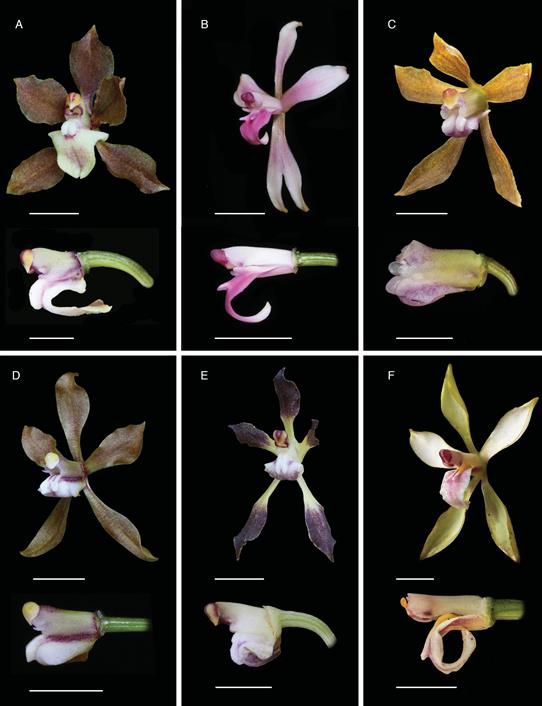Introduction
The circumscription of Cyrtochilum Kunth, with over 180-190 currently accepted species, has been contentious, along with the circumscription of related genera including Odontoglossum Kunth and Oncidium Sw. (Dalström 2012). As presently circumscribed, Cyrtochilum is mainly characterized by having ovoid pseudobulbs, conduplicate leaves, large and flexuous, branched inflorescences, resupinate flowers with mostly free sepals and petals, generally with an ovate to triangular lip with a more or less complex callus, consisting of keels and knobs in various shapes, a straight to sigmoid column with a large stigmatic cavity and two elongate pyriform cleft pollinia.
The species currently attributed to Cyrtochilum are distributed mainly in South America from Venezuela to Bolivia at 1500-3500 m in elevation, with only one species, Cyrtochilum meirax (Rchb.f.) Dalström occurring in the Caribbean. The largest number of species are found in the Andes where usually occur as epiphytes or lithophytes in cloud forests. In Colombia about 70-85 species are reported (Ortiz Valdivieso & Uribe Vélez 2007, Bernal et al. 2015). Here we describe a new species of Cyrtochilum from the Eastern Cordillera in Colombia.
Materials and methods
Plant material was prepared at the herbarium of the Jardín Botánico José Celestino Mutis (JBB) in Bogotá. Photographs of the detailed and dissected species were taken with a Canon EOS T3 camera fitted with a macro lens (EF-S 60 mm f/2.8). A Lankester Compose Digital Plate (LCDP) was prepared and diagrammed with Adobe Photoshop 5.0. Sketches were traced from the LCDP using a Wacom Bamboo CTH-460 and printed on smooth Fabriano paper of 240 gr. and repainted with a Shinhan Touch Liner 0.05 and 0.1 mm.
Taxonomic treatment
Cyrtochilum albovirens N. Gutiérrez & P. Harding sp. nov. (Figure 1-3, 5, 6F).
TYPE: Colombia. Santander: Vélez Province, Municipo de La Belleza, Vereda Vistahermosa, Finca Moravia, 5 51 54.14 N 73 55 46.79 W, 2381 m, July 2016, David E. Granados (DEG) 555 (holotype: JBB).
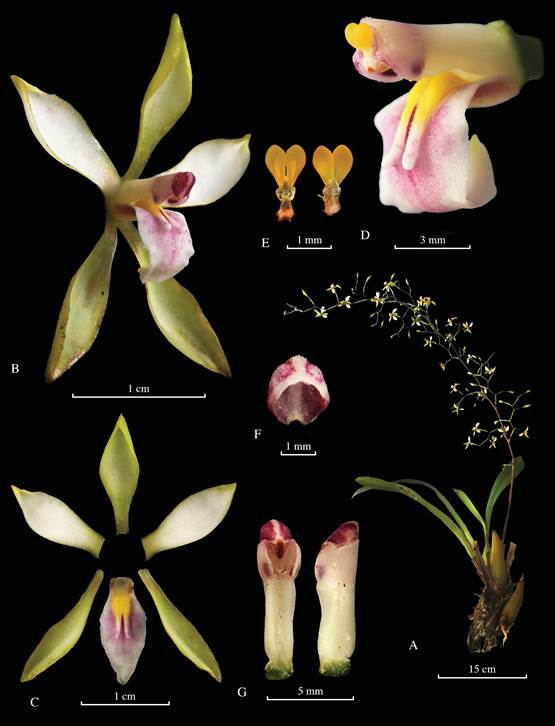
Figure 1 Cyrtochilum albovirens. A. Plant habit. B. Flower. C. Dissected perianth. D. Column and lip. E. Pollinarium, front and back views. F. Anther cap. G. Column lateral and ventral views. Photographs by Nicolás Gutiérrez Morales, from the plant that served as type.
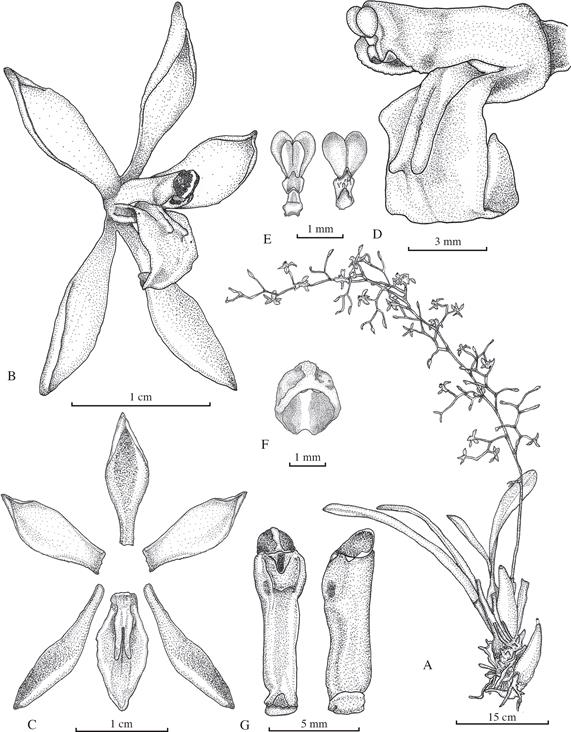
Figure 2 Illustration of Cyrtochilum albovirens. A. Habit. B. Flower. C. Dissected perianth. D. Column and lip. E. Pollinia. F. Anther. G. Column, dorsal and ventral view. Drawing by Juan Sebastián Moreno, from the plant that served as type.
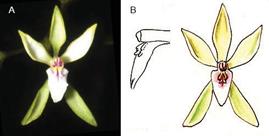
Figure 3 Additional material studied of Cyrtochilum albovirens. A. Photograph. B. Drawing. Photograph and illustration by Padre Ortiz-Valdivieso, from Ortiz-Valdivieso & Uribe- Vélez (2007).
Diagnosis. Cyrtochilum albovirens is vegetatively similar to Cyrtochilum distans (Rchb.f.) Kraenzl. with similar leaves, pseudobulbs and inflorescence, but distinguished mainly by having yellow-green and free lateral sepals and a basally yellow and apically white lip callus terminating in two parallel keels (vs. pink lateral sepals that are fused for half or more of their length, and a white lip callus consisting of two basal and two apical spreading keels for C. distans).
Epiphytic, caespitose herb. Pseudobulbs ovoid and slightly flattened, glossy green with brown markings at the base when exposed to sun, becoming orange-brown with age, bifoliate, surrounded basally by 3 to 4 foliaceous and deciduous, distichous sheaths, 8-11 × 2-4 cm. Leaves conduplicate, sessile, obovate-ligulate, obtuse, 25-56 × 3-4 cm. Inflorescence axillary from the uppermost sheath, an erect to arching panicle with multiple few-flowered side-branches, ca. 120 cm long. Bracts appressed, scale-like, ca. 1-2 cm. Pedicel with ovary to 3 cm long. Flowers stellate. Dorsal sepal yellow-green, basally shortly spathulate, then broadly elliptic, acute, apically involute, 1.2-1.6 × 0.4-0.5 cm. Lateral sepals similar in color and shape, free and spreading, slightly oblique, 1.5 × 0.3 cm. Petals whitish green, broadly unguiculate to almost sessile, then elliptic and indistinctly oblique, acute, 1.2-1.3 × 0.5-0.6 cm. Lip basally white, suffused with pink from the base of the callus towards the margins and apex and with a slightly darker midvein, rigidly fused to the column basally through a short ventral, longitudinal keel, elongated rhomboid with indistinct lateral lobes and an obtuse front-lobe, reflexed at 1/4 of its length, 1.0-1.2 × 0.5-0.6 cm; callus basally yellow, turning light pink to white apically, consisting of a swollen, two-ridged and hump-like basal part, emerging ca. 2 mm from the base of the lip, turning into a pair of parallel digitate keels extending to about half the length of the lip lamina. Column basally white and apically pale purplish, straight, stout, ventrally shallowly canaliculated, ca. 0.7 cm long. Anther cap white suffused with purple, globular and campanulate, ca. 2 mm broad. Pollinarium ca. 1.5 mm long, of two pyriform cleft/folded pollinia on a ca. 0.5 mm long almost diamond-shaped involute stipe, on a pulvinate viscidium.
Additional Material studied
Colombia. Boyacá, in the canyon of the Pómeca river in Arabuco, 5 48 44.6 N 73 28 37.8 W, Ortiz-Valdivieso & Uribe-Vélez s.n. (Cyrtochilum sp. 05 in Ortiz-Valdivieso & Uribe-Vélez 2007, photo, drawing) (Figure 3). Plants were observed by one of the authors (PH) in Bolivar, Santander, along the road to El Peñón, 6 02 56.7 N 74 11 47.1 W, at 2600 m elevation, July of 2016. Additional plants have been seen in private collections and shows in Bogotá. The American Orchid Society awarded a plant at the Bogotá show in 2015 (No. 20151928).
Distribution. Cyrtochilum albovirens is only known from the Eastern Cordillera of the Colombian Andes, in the departments of Santander and Boyacá (Figure 4). The type plant was found in La Belleza growing next to plants of Odontoglossum lindleyanum Rchb.f. & Warsz., Cyrtochilum mandibulare (Linden & Rchb.f.) Kraenzl. and Ornithidium ruberrimum (Lindl.) Rchb.f. on a tree of the Verbenaceae family growing in pasture close to a relict forest. The plant that became the holotype was growing epiphytically ca. 6 m above the ground. These pastures are part of a family dairy farm called Moravia, whose owners are concerned about the conservation of the biodiversity.
Etymology. From the Latin “albus”, white and “virens”, green. In allusion to the white-green sepals and green-yellow petals.
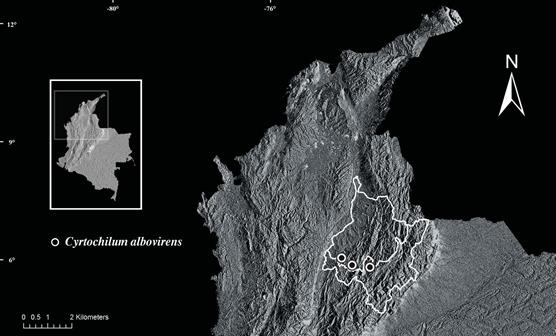
Figure 4 Distribution map of Cyrtochilum albovirens, distributed in La Belleza and Bolivar, Santander and Arcabuco, Boyacá in Colombia. The specimens presented in Bolivar and Arcabuco are from unvouchered observations.
Cyrtochilum albovirens (Figure 5F) with its white and yellow-green flowers is easily recognized by the rhomboid pink lip, basally yellow and apically white callus that terminates in a pair of parallel digitate keels. The new species is easily distinguished in a fresh state due to the combination of yellow-green sepals and the bi-colored lip callus. In a dried state, it may superficially resemble other small-flowered Cyrtochilum species, such as Cyrtochilum confertum (Rchb.f.) Dalström (Figure 5A), Cyrtochilum distans (Rchb.f.) Kraenzl. (Figure 5B), Cyrtochilum funis (F.Lehm. & Kraenzl.) Kraenzl. (Figure 5C), Cyrtochilum longifolium (Lindl.) Kraenzl. (Figure 5D), and Cyrtochilum myanthum (Lindl.) Kraenzl. (Figure 5E) but can be distinguished from all by the raised and hump- like base of the callus, which extends in a rather straight direction down from the column in a ca. 45º angle. In other words, the callus does not curve and follow the more or less reflexed lamina of the lip. In addition, all of these here mentioned superficially similar species have distinct ventral column lobes that clasp the sides of the lip callus. Cyrtochilum albovirens does not have any ventral column lobes and actually appears more similar to larger-flowered species, such as C. auropurpureum (Rchb.f.) Dalström and C. revolutum (Lindl.) Dalström in that aspect. Cyrtochilum albovirens may look like a differently colored form of Cyrtochilum distans but the callus differences described above will easily tell the species apart.












 uBio
uBio 
